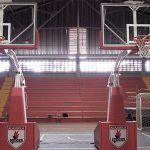$151.7 million, down 22.9% to $196.7 million a year ago. The loss from
operations was $6.9 million compared to a loss of $3.9 million a year ago. The net
loss was $14.8 million compared to $13.3 million a year ago.
For the first quarter 2009, the company reported earnings
before interest, taxes, depreciation and amortization (EBITDA) loss of $2.3
million compared to EBITDA of $0.8 million for the first quarter 2008. Excluding
certain restructuring, integration and other highlighted charges discussed
below, the EBITDA loss was $1.2 million compared to EBITDA of $1.4 million a
year ago.
The company has three operating segments:
“Broder,” “Alpha” and “NES.” The Broder division
generated first quarter 2009 net sales of $61.3 million compared to $74.6
million in the first quarter 2008. The Alpha division generated first quarter
2009 revenue of $73.2 million compared to $98.2 million in the first quarter
2008. The NES division generated net sales of $17.2 million in the first
quarter 2009 compared to $23.9 million in the first quarter 2008.
First quarter 2009 gross profit was $25.0 million compared
to $33.3 million for the first quarter 2008. First quarter 2009 gross margin
was 16.5% compared to gross margin of 16.9% in the prior period. The decrease
in gross profit was attributable to lower unit volumes partially offset by
higher average selling prices. Softened demand for the products the company
sells due to weakened
economic conditions led to the decrease in unit volume. According to industry
data gathered from the company and many of its competitors by AC Nielsen and
reported by STARS, the overall industry unit shipments declined by 18% during
the quarter.
Highlighted Charges for the First Quarter 2009 and First
Quarter 2008
Results for the three months ended March 28, 2009 and March
29, 2008 include certain charges as follows:
(dollars in millions)
(Unaudited)
Three Months Ended
2009 2008
Restructuring
charges, net $0.5 $0.3
Stock-based
compensation
0.1 0.1
Management
fee
0.0 0.1
Facilities
consolidation-related charges
0.0 0.1
Other highlighted
charges 0.5 0.0
Total highlighted
charges $1.1 $0.6
Restructuring charges recorded during the first quarter of
2009 consisted primarily of severance costs related to a reduction in force
that occurred in March 2009. Other highlighted charges include approximately
$0.4 million in inventory management consulting charges and $0.1 million in
consulting charges related to the exchange offer.
Restructuring charges recorded during the first quarter of
2008 consisted of severance costs of $0.1 million and interest accretion on
restructuring charges. Facilities consolidation-related charges consisted of
commission expense to sublease a facility closed in connection with the company's
recently completed distribution center consolidation.
Liquidity Position
The company relies primarily upon cash flow from operations
and borrowings under its revolving credit facility to finance operations,
capital expenditures and debt service requirements. Borrowings and availability
under the revolving credit facility fluctuate due to seasonal demands.
Historical borrowing levels have reached peaks during the middle of a given
year and low points during the last quarter of the year.
Borrowings under the revolving credit facility were $131.8
million at March 28, 2009 compared to $150.0 million at December 27, 2008 and
$132.0 million at March 29, 2008. The company's revolving credit facility that
was amended and restated in August 2006 provided for aggregate borrowings up to
$225.0 million, subject to borrowing base availability. In April 2009, the company
entered into an amendment, waiver and consent (the “First Amendment”)
of the company's revolving credit facility, which reduced the commitment to
$200.0 million, among other items. Borrowing base availability at March 28,
2009, December 27, 2008 and March 29, 2008 was $25.7 million, $35.9 million and
$60.5 million, respectively.
After executing the First Amendment April 9, 2009, executing
two additional credit agreement amendments on April 28, 2009 and completing the
exchange offer on May 20, 2009, the company believes it has achieved stable
bank and stable bond financing. Management believes that obtaining stable
vendor financing is the final component to improving the company's inventory
levels and inventory quality, which is expected to result in market share gains
during fiscal 2009. Subsequent to the May 15, 2009 announcement that
approximately 95% of the 2010 notes were validly tendered and not withdrawn,
key suppliers increased credit limits and began shipping significant amounts of
inventory on commercially reasonable terms. None of the company's key suppliers
currently require the company to pay cash in advance or cash on delivery.
Management believes that it has the ability to manage cash
flow and working capital levels, particularly inventory and accounts payable,
to allow the company to meet its current and future obligations during its
seasonal liquidity low point in June 2009, pay scheduled principal and interest,
and provide funds for working capital, capital expenditures and other needs of
the business for at least fiscal 2009. Additional information regarding the company's
liquidity position can be found in the company's Quarterly Report for the
period ended March 28, 2009 which was posted to the company's corporate website
on May 26, 2009.
Selected Balance
Sheet Information
(dollars in millions)
(Unaudited)
March 28,
December 27, March 29,
2009 2008 2008
Accounts
Receivable, Net $61.0 $72.4 $86.3
Inventory (1) 200.8 235.5
241.0
Accounts Payable
(1) 70.4 87.6 118.5
Revolving Credit
Debt 131.8 150.0 132.0
59.6 70.3 76.8
Senior Notes $225.0 $225.0
$225.0
Shareholders'
Equity $(141.6) $(126.9)
$(71.6)
(1) Inventory and
accounts payable at March 2009, December 2008 and March
2008 include
accruals for inventory in-transit between suppliers and
company
distribution centers of $12.6 million, $12.8 million and $6.5
million,
respectively.
Business Outlook
The company's business is sensitive to the business cycle of
the national economy. Deterioration in general economic conditions adversely
affect demand for the company's products, and cause sales of the company's
products to decrease. In addition, slowdowns in economic activity result in the
company's customers shifting their purchases towards lower-priced products, such
as T-shirts, which adversely affects gross profit margin. The current economic
downturn has negatively impacted the imprintable sportswear market, causing a
dramatic decrease in sales during the fourth quarter of 2008 which continued
into 2009. Overall, the market for imprintable activewear shrank by at least 6%
in 2008, including at least 11% in the fourth quarter of 2008, and 18% in the
first quarter of 2009. Such conditions are not expected to improve
significantly in the near-term. The current economic crisis has caused many of
the company's customers to cancel or scale back corporate events and purchases
of products such as those the company sells. This reduced customer demand has
adversely affected the company's revenues and operating profits through reduced
purchases of the company's products.
Management believes that revenue and gross profit will be
less during fiscal 2009 compared to the same periods in fiscal 2008 due to the
softened demand for the company's products. In December 2008, the company
initiated headcount reductions by eliminating approximately 140 positions in
its distribution centers, call centers, management and other corporate
functions in anticipation of a further weakening in the
eliminated approximately 60 positions in its distribution centers, management
and other corporate functions in response to a further weakening of the
economy. The headcount reductions have reduced annual operating expenses by at
least $13 million in the aggregate. Management does not believe that customers
have been adversely impacted by the headcount reductions and the company has no
intention to increase headcount should market conditions improve during fiscal
2009 or fiscal 2010.
The company's metrics for its distribution center and call
center operations improved during the first quarter 2009 and the company
simultaneously reduced its variable operating expenses. Variable operating
expenses continue to be responsive to unit volumes.
“I'd like to thank all of our customers for staying
with us through our financial turmoil. Having completed the series of
transactions that improved our capital structure, management will have more
time to devote to our customers and help them grow their businesses. I'd also
like to thank our employees for doing their part to keep the business strong
and for displaying a positive attitude to co-workers, customers and suppliers.
Finally, I'd also like to thank our major suppliers for supporting us through
this process,” commented Tom Myers, the company's CEO.
First Quarter 2009
Results Compared to Preliminary Results Issued April 23, 2009
On April 23, 2009, the company filed a Current Report on
Form 8-K, which included a summary of presentation materials to holders of the
$225.0 million 11 1/4% senior notes due 2010 relating to the exchange offer for
the existing notes, which commenced on April 17, 2009 and settled on May 20,
2009. The Current Report included preliminary results for the first quarter of
2009.
The unaudited results for the first quarter of 2009 are in
line with the preliminary results and are set forth in a table at the end of
this release. Actual revenues of $151.7 million remained unchanged compared to
the preliminary results. Gross profit of $25.0 million was $0.1 million less
than the gross profit of $25.1 million included in the preliminary results and
net loss was $14.8 million compared to a $14.5 million net loss included in the
preliminary results. Results include the impact of certain restructuring and
other highlighted charges discussed below. Excluding these highlighted charges,
the company reported an EBITDA loss of $1.2 million compared to an EBITDA loss
of $1.0 million included in the preliminary results.
Fourth Quarter and
Fiscal 2008 Results Compared to Preliminary Results Reported March 31, 2009
On March 31, 2009, the company issued its preliminary
unaudited financial results for its fourth quarter and fiscal year ended
December 27, 2008. On May 22, 2009, the company filed its Annual Report on Form
10-K for the year ended December 27, 2008. A table set forth at the end of this
release includes the preliminary results and the final results.
Actual revenues for the fourth quarter 2008 of $219.5
million remained unchanged compared to the preliminary results. Gross profit of
$41.4 million was $0.3 million higher than the gross profit of $41.1 million
included in the preliminary results and net loss was $54.0 million compared to
a $60.3 million net loss included in the preliminary results. Results include
the impact of certain restructuring and other highlighted charges discussed
below. Excluding these highlighted charges, EBITDA for the fourth quarter 2008
was $7.5 million compared to $10.2 million included in the preliminary results.
The $2.7 million reduction in EBITDA, excluding the
highlighted charges, was due to a $1.5 million increase to the company's
allowance for doubtful accounts resulting from the deterioration in the company's
receivables portfolio and a net $1.2 million adjustment related to inventory
costing. The adjustment to inventory costing was the result of an adjustment to
the company's capitalized freight balance.
Highlighted Charges
for the Fourth Quarter and Fiscal 2008
Results for the three and twelve months ended December 27,
2008 and March 29, 2008 include certain charges as follows:
(dollars in millions)
(Unaudited)
Three Months Twelve Months
&n















